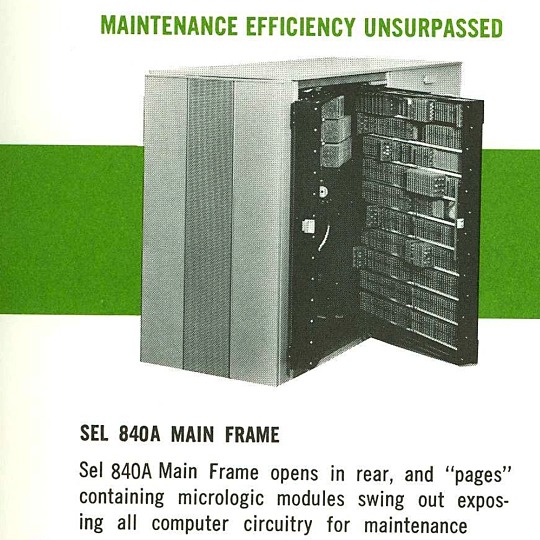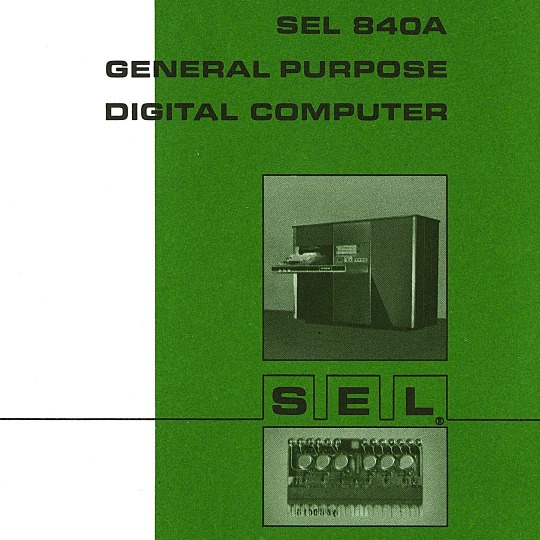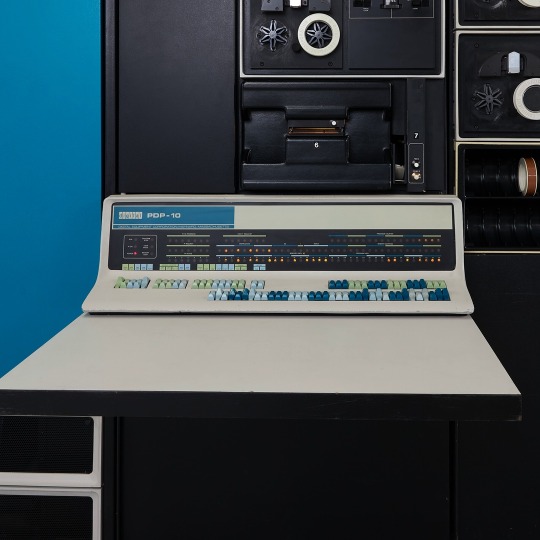#xeroxalto
Explore tagged Tumblr posts
Text






🎄💾🗓️ Day 11: Retrocomputing Advent Calendar - The SEL 840A🎄💾🗓️
Systems Engineering Laboratories (SEL) introduced the SEL 840A in 1965. This is a deep cut folks, buckle in. It was designed as a high-performance, 24-bit general-purpose digital computer, particularly well-suited for scientific and industrial real-time applications.
Notable for using silicon monolithic integrated circuits and a modular architecture. Supported advanced computation with features like concurrent floating-point arithmetic via an optional Extended Arithmetic Unit (EAU), which allowed independent arithmetic processing in single or double precision. With a core memory cycle time of 1.75 microseconds and a capacity of up to 32,768 directly addressable words, the SEL 840A had impressive computational speed and versatility for its time.
Its instruction set covered arithmetic operations, branching, and program control. The computer had fairly robust I/O capabilities, supporting up to 128 input/output units and optional block transfer control for high-speed data movement. SEL 840A had real-time applications, such as data acquisition, industrial automation, and control systems, with features like multi-level priority interrupts and a real-time clock with millisecond resolution.
Software support included a FORTRAN IV compiler, mnemonic assembler, and a library of scientific subroutines, making it accessible for scientific and engineering use. The operator’s console provided immediate access to registers, control functions, and user interaction! Designed to be maintained, its modular design had serviceability you do often not see today, with swing-out circuit pages and accessible test points.
And here's a personal… personal computer history from Adafruit team member, Dan…
== The first computer I used was an SEL-840A, PDF:
I learned Fortran on it in eight grade, in 1970. It was at Oak Ridge National Laboratory, where my parents worked, and was used to take data from cyclotron experiments and perform calculations. I later patched the Fortran compiler on it to take single-quoted strings, like 'HELLO', in Fortran FORMAT statements, instead of having to use Hollerith counts, like 5HHELLO.
In 1971-1972, in high school, I used a PDP-10 (model KA10) timesharing system, run by BOCES LIRICS on Long Island, NY, while we were there for one year on an exchange.
This is the front panel of the actual computer I used. I worked at the computer center in the summer. I know the fellow in the picture: he was an older high school student at the time.
The first "personal" computers I used were Xerox Alto, Xerox Dorado, Xerox Dandelion (Xerox Star 8010), Apple Lisa, and Apple Mac, and an original IBM PC. Later I used DEC VAXstations.
Dan kinda wins the first computer contest if there was one… Have first computer memories? Post’em up in the comments, or post yours on socialz’ and tag them #firstcomputer #retrocomputing – See you back here tomorrow!
#retrocomputing#firstcomputer#electronics#sel840a#1960scomputers#fortran#computinghistory#vintagecomputing#realtimecomputing#industrialautomation#siliconcircuits#modulararchitecture#floatingpointarithmetic#computerscience#fortrancode#corememory#oakridgenationallab#cyclotron#pdp10#xeroxalto#computermuseum#historyofcomputing#classiccomputing#nostalgictech#selcomputers#scientificcomputing#digitalhistory#engineeringmarvel#techthroughdecades#console
31 notes
·
View notes
Text
The Majestic Birth of Graphical User Interfaces – Xerox Alto and the Alto Trek game

Can you imagine a time before the Graphical User Interface, when you could only operate a computer with abstract-looking text instead of using simple menus, and it was unheard of to use the oh-so-common mouse? A time when computers were harder to learn, and even harder to master? Well then, join us in our splendid trip where we’ll discover one of the very first GUIs in a personal computer, found on the Xerox Alto!
Disponibile anche in 🇮🇹
https://blisscast.wordpress.com/2024/02/20/xerox-alto-trek-gui-wonderland-1/
0 notes
Text
@xeroxalto tagged me to post 4 non-selfies from my camera roll. im not good at these bear with me




a hearty mix of nature and scrap metal.
i’ll tag @illusionaryneil @danelloevee @gatored annnnd @howlvetink (you don’t have to do this at all don’t mind me LOL. you can instead pretend i am waving at you. hellooo hello)
#tag games#<- just in case for filtering#squoob says a thing#i’ve been on a lot of trips recently! hopefully this is the last one in a while i’m very exhausted X(
18 notes
·
View notes
Text
@xeroxalto tagged me to post four non selfies from my camera roll




i'll tag @femmefitz @charmcoin @shockimage @toby-werewolf @kingcatnine and anyone else who wants to do this
#i tried to make mine a coherent moodboard but i dont think you need to do that lol#also if u dont wanna do it or already did just ignore my tag ^_^~<3#my pics
7 notes
·
View notes
Text
@cruelify tagged me to post 4 non selfies from my camera roll... here u go




id: first photo is 4 nail polish swatch sticks showing the same nail polish by itself and over a couple light bases and a black base. it's baja blast turquoise. my own nails are censored with a shiny teddiursa and a sticker of my dog Winston.
second photo is an unknown beetle on a hardwood floor.
third photo is of Winston. he's a light brown whippet and the angle is from below and straight on with his face, his front teeth are showing a little bit and he looks a little goofy.
fourth photo is of the Jumbotron at Rogers Place at the end of an Oilers game where they beat the Dallas Stars 4-1. it shows Stuart Skinner still in his goalie gear being interviewed by Gene Principe after being named 2nd star of the game. /end id]
I will tag... @officiallanxichen @mutttooth @xeroxalto @lostjudgmnt and anyone else who feels like doing this can say I tagged u :)
6 notes
·
View notes
Text
@xeroxalto tagged me to post four pics from my camera roll!




and i tag @kazpng @shockimage @nesmithmike @teleportzz :)
if anyone else wants u can say u were tagged by meeeeeee
3 notes
·
View notes
Text


@xeroxalto sorry about the multitude of shades, so many of the items tagged as teal don't match lmao
4 notes
·
View notes
Text



La historia del GUI en computación
En los años 60, el pionero de la informática Douglas Engelbart había conceptualizado la interfaz gráfica de usuario. Imaginó un sistema informático que utilizara hipertexto, sistema operativo basado en ventanas y videoconferencia. También se le ocurrió el concepto del mouse de la computadora.
En Xerox PARC fue donde la GUI finalmente encontró su camino en un producto funcional, que puso al desconocido Bob Taylor y varias mentes brillantes más a trabajar en ello y en 1973, el equipo de PARC desarrolló la computadora "personal" Xerox Alto, compatible con la visualización de mapas de bits y el sistema operativo basado en ventanas e iconos, GUI y el editor WYSIWYG (Lo que ves es lo que obtienes). También tenía un mouse y un teclado, y un puerto de cable Ethernet.
Aunque la Xerox Alto era un producto funcional y se denominaba "Personal Computer" nunca fue vendida al consumidor final como producto comercial. Solo algunas universidades y campos de investigación tenian unas cuantas. Costaba el equivalente de 100 000 usd de hoy. y solo se construyeron 2 mil.
Apple Lisa y Mac, o Microsoft con Windows no fueron los primeros en contar con un SO basado en cuersor, apuntar y clic y un sistema de organización de archivos basado en vantanas, con soporte de red via modem o ethernet. Que distinta hubiera diso la historia de no ser por los "cabezas de tóner"
#retrocomputingmx #GuiSystem #xeroxalto #DouglasEngelbart
2 notes
·
View notes
Text
Historia del GUI, parte 3: Xerox Alto




Sin duda el Xerox Alto era un ordenador muy avanzado para la época, que se usaba para la investigación sobre la interacción humano-tecnológica y el uso de ordenadores. Inclusive había entornos de programación para esta máquina, como el BCPL y MESA, lenguaje de bajo nivel que podían usar el microcódigo del CPU. Sin olvidar el SmallTalk y Lisp de alto nivel, interactivos y orientado a objetos. Xerox sin duda, marcó la pauta. De hecho utilizaron esta tecnología no comercial para crear el procesador de documentos Xerox 8010 también conocido como "Xerox Star". Todo esto movió a Steve Jobs cuando visitó PARC para crear un sistema aún más robusto donde agrego menús desplegables, arrastrar y soltar, barras de menú y el "Copy+Paste" moderno del cual hablaremos posteriormente 📸: ToastyTech #retrocomputingmx #historiadelgui #xeroxalto
0 notes
Photo









sALto - The xerOX ALTo siMuLaTOr PT#2
115 notes
·
View notes
Video
youtube
[Restored] Xerox Alto Demo - YouTube
0 notes
Photo

XeroxAlto, Ancestor of all GUI .png
11 notes
·
View notes
Text
@xeroxalto this thing reminds me of nemo
WHAT THE FUUUUUUCK ME ME ME ME ME ME
61K notes
·
View notes
Text
Historia del GUI, parte 2: Xerox Alto




Mas fotos del Xerox Alto: Neptune file Manager Bravo, el editor de textos WYSIWYG Draw, programa de dibujo bitmap (los objetos eran definidos y manipulables de forma individual) MazeWar, juego de años antes al Doom, en 3D, jugable por red, multijugador, portado al Alto. Continuará... 📸: ToastyTech #retrocomputingmx #historiadelgui #xeroxalto
0 notes
